There are many titles associated with service in the Navy. And to further complicate things, the different military services share some titles and use different ones for others. Understanding all of this can be challenging.
Major Topics Covered:
![]()
![]() Billets
Billets
![]()
![]() Pay Grades
Pay Grades
![]()
![]() Ranks
Ranks
![]()
![]() Naval Enlisted Classification (NEC) Codes
Naval Enlisted Classification (NEC) Codes
![]()
![]() Warfare Specialties
Warfare Specialties
![]()
![]() Forms of Address
Forms of Address
![]()
![]() Rates and Ratings
Rates and Ratings
To Learn More:
![]()
![]() www.usni.org/BlueAndGoldProfessionalBooks/TheBluejacketsManual
www.usni.org/BlueAndGoldProfessionalBooks/TheBluejacketsManual
![]()
![]() Basic Military Requirements (NAVEDTRA 14325)
Basic Military Requirements (NAVEDTRA 14325)
![]()
![]() Personnel Specialist: Basic Training Manual (NAVEDTRA 15006A)
Personnel Specialist: Basic Training Manual (NAVEDTRA 15006A)
![]()
![]() Officers’ Ranks, www.navy.mil/navydata/ranks/officers/o-rank.html
Officers’ Ranks, www.navy.mil/navydata/ranks/officers/o-rank.html
Associated Tabs:
![]()
![]() TAB 5-A: Pay Grades, Ranks, Rates, and Forms of Address in the Armed Forces
TAB 5-A: Pay Grades, Ranks, Rates, and Forms of Address in the Armed Forces
![]()
![]() TAB 5-B: Navy Ratings
TAB 5-B: Navy Ratings
![]()
![]() TAB 5-C: General Rates
TAB 5-C: General Rates
![]()
![]() TAB 5-D: Examples of Enlisted Career Advancement
TAB 5-D: Examples of Enlisted Career Advancement
5-A Pay Grades, Ranks, Rates, and Forms of Address in the Armed Forces
NAVY
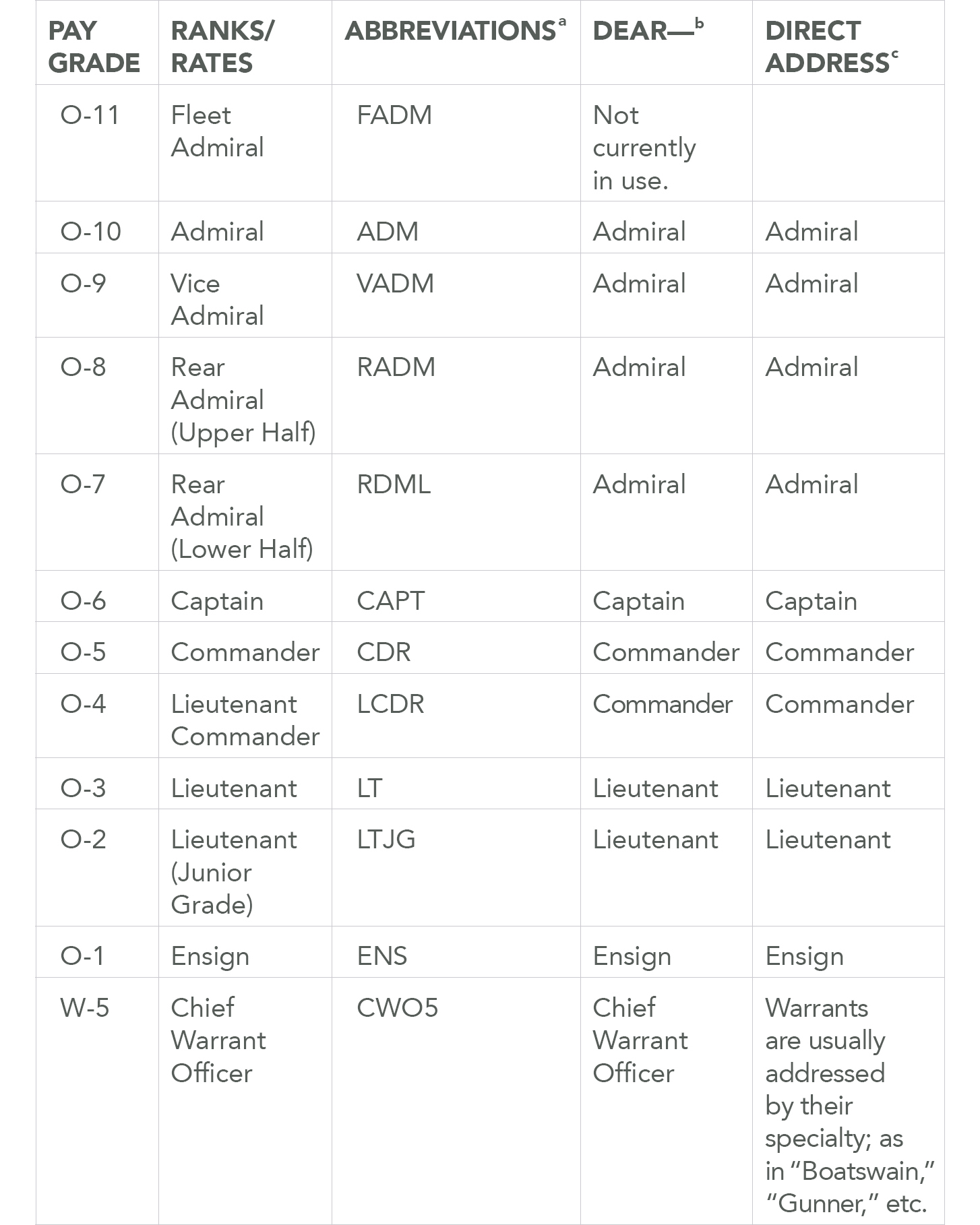


MARINE CORPS
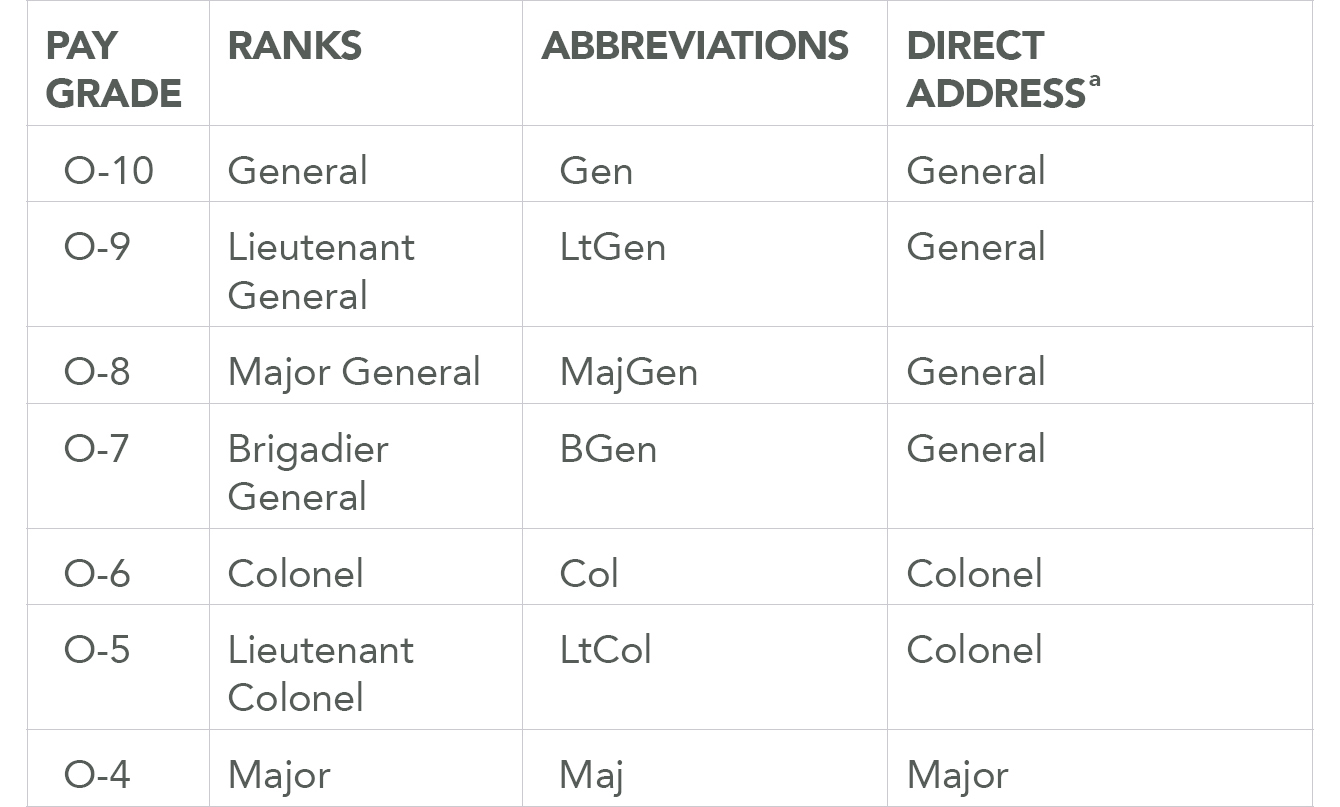
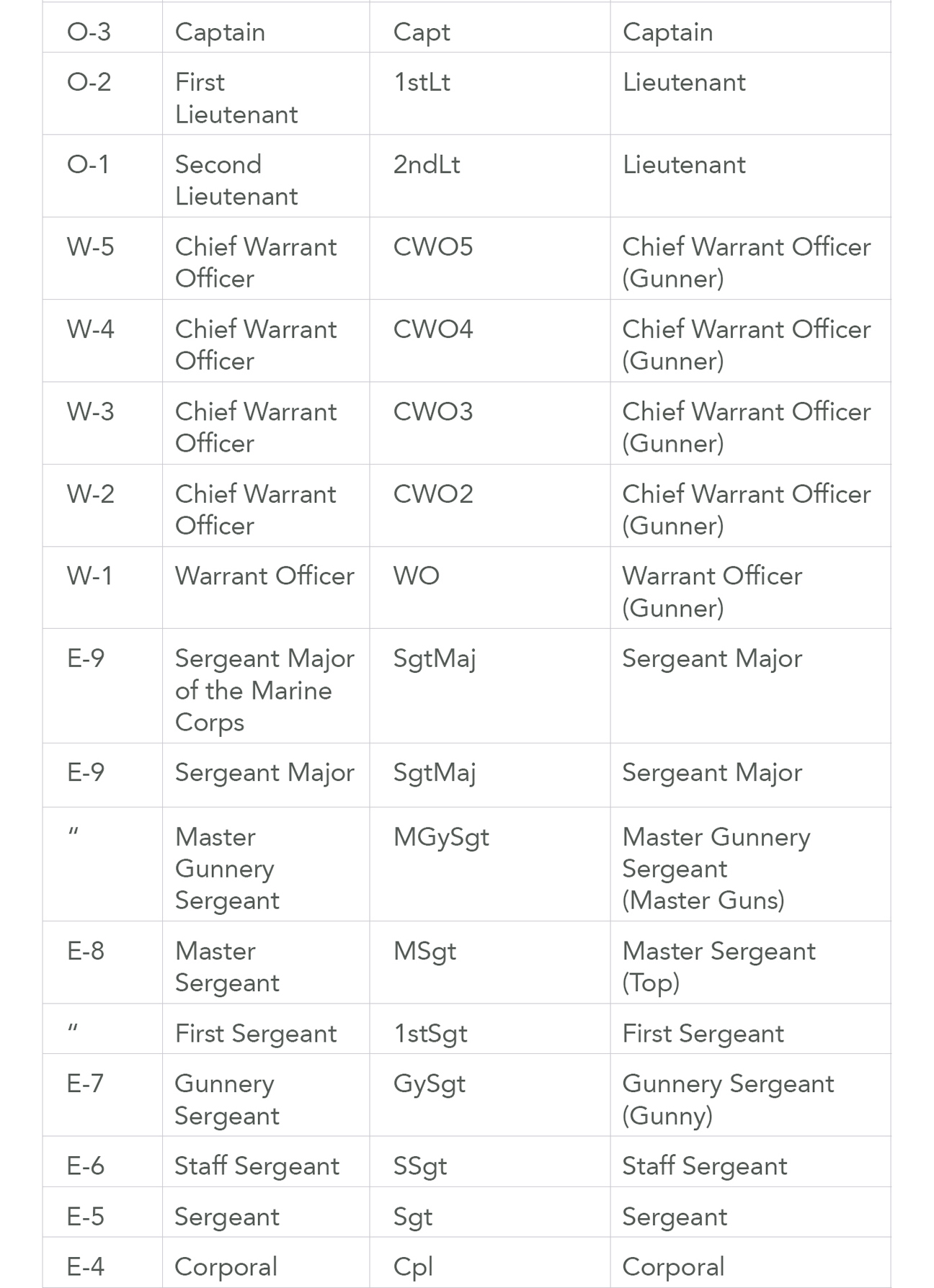

COAST GUARD
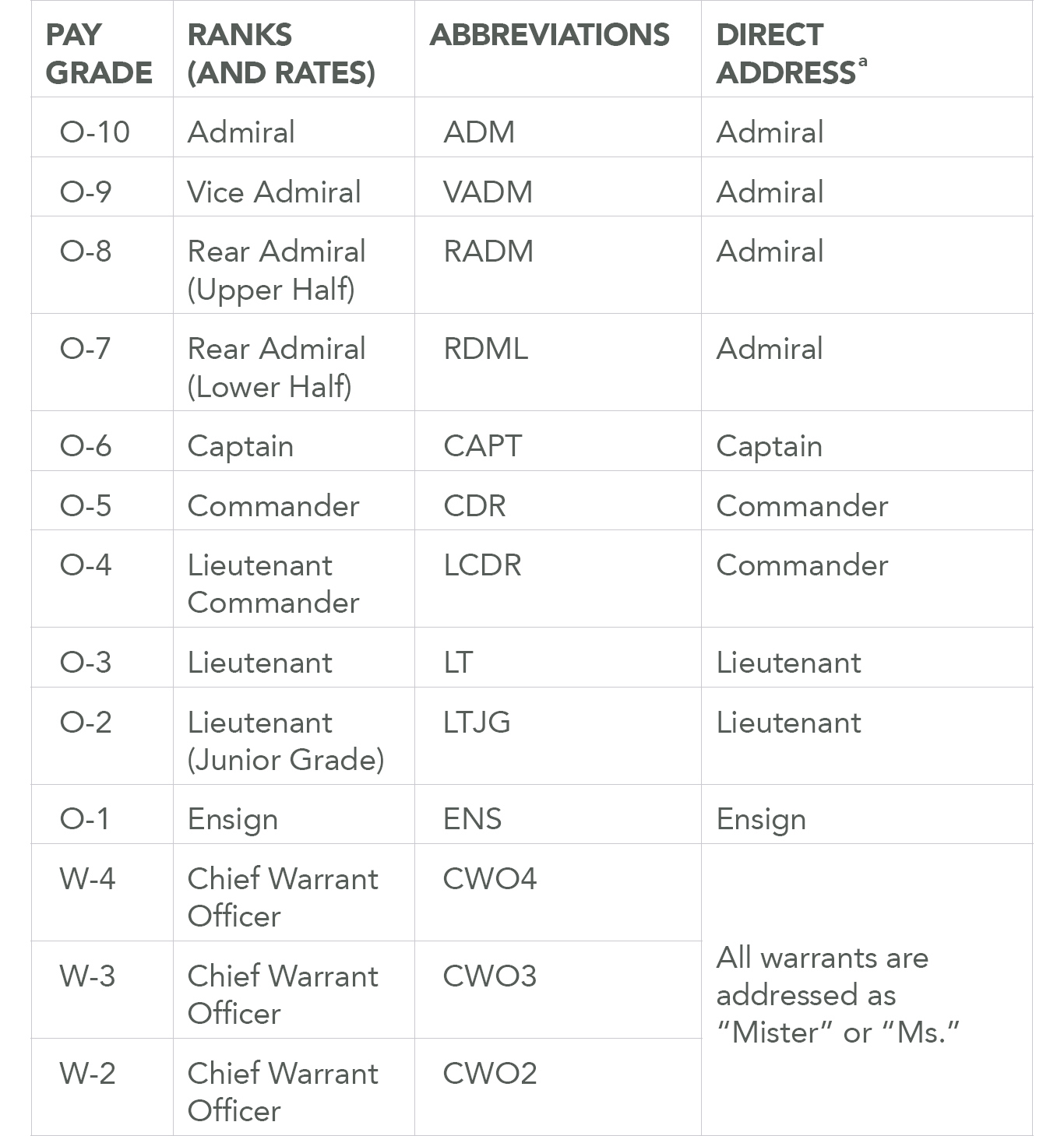
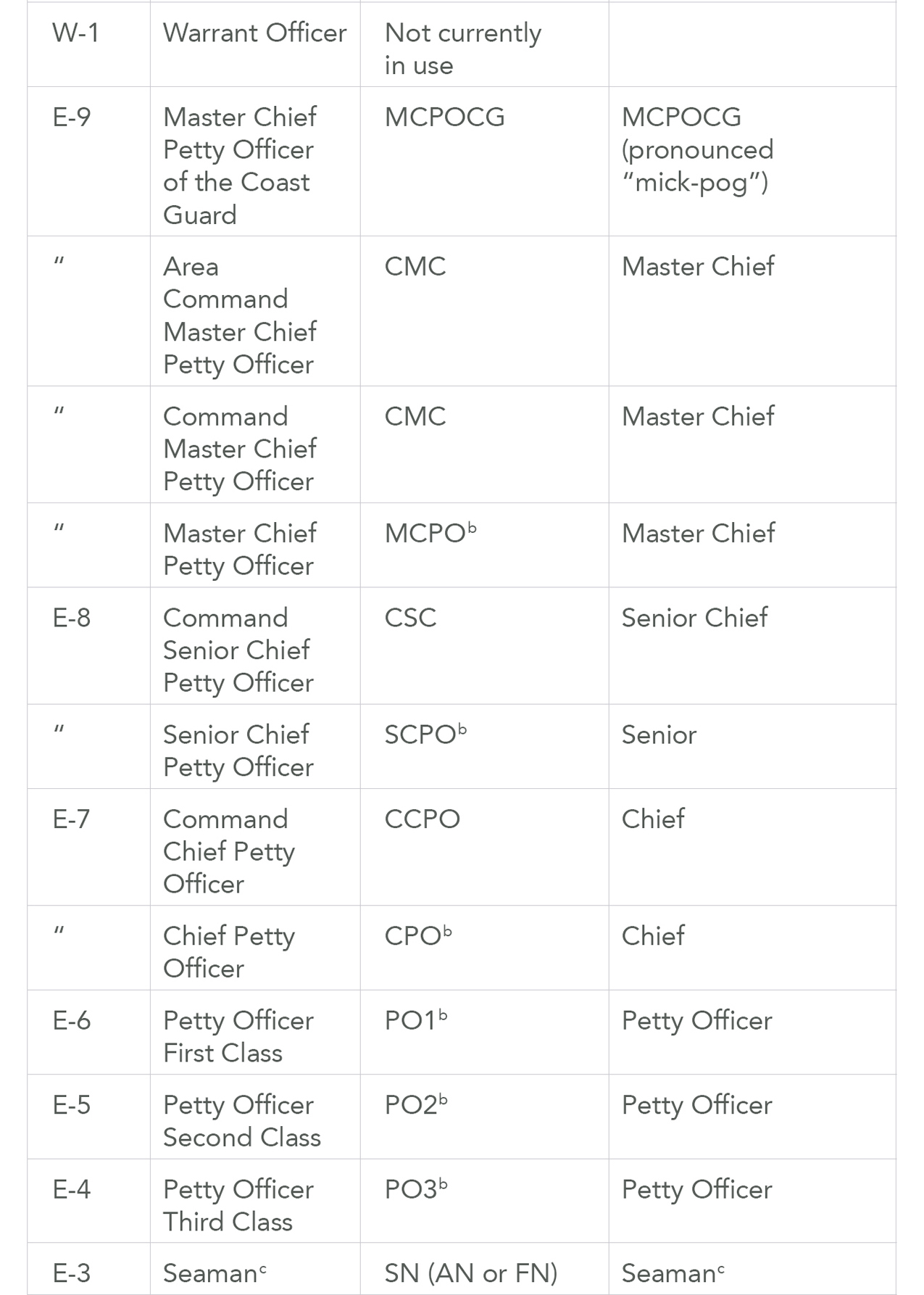
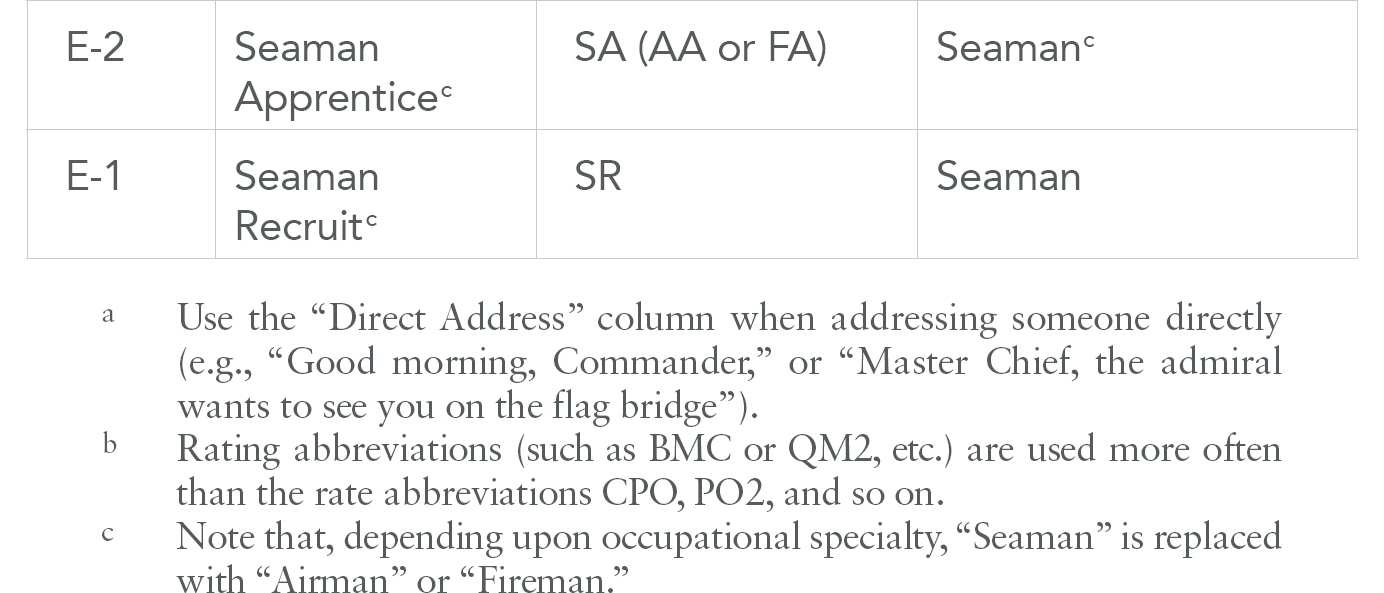
ARMY
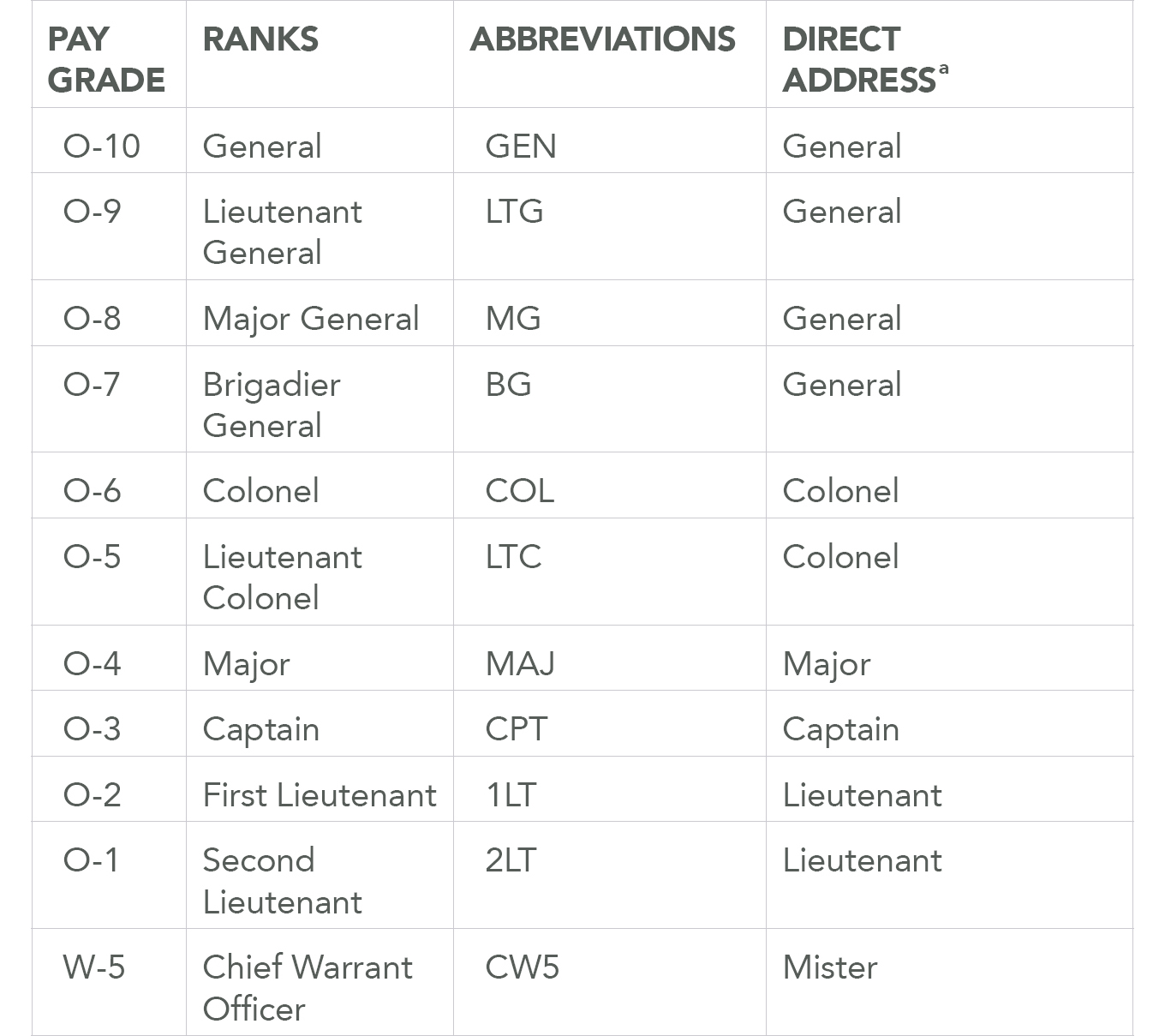

AIR FORCE


A rating is an occupational specialty in the Navy. You might call it a “job” or an “occupation” in the civilian world. Before Sailors can qualify for a rating, they must first work their way through the “general apprenticeship levels” (E-1 to E-3), which helps prepare them for a rating. In order to advance beyond the E-3 pay grade, Sailors must have a rating. Once promoted to E-4, they have a rating and, except in special circumstances, will likely keep that rating for the rest of their careers.
Each of the Navy’s ratings is identified by a two- or three-letter abbreviation such as ET (for electronics technician) or GSM (for gas turbine systems technician—mechanical). Each rating is further identified by a unique symbol, called a specialty mark, that is included on a rating badge worn on the left sleeve of dress uniforms.
There are two categories of ratings: general and service. Occupations for pay grades E-4 through E-9 are called general ratings. Each general rating has a distinctive badge. Examples of general ratings are operations specialist, gunner’s mate, and logistics specialist.
Some general ratings are further subdivided into service ratings, which indicate some additional specialization. For example, the general rating of gas turbine systems technician (GS) is subdivided into two service ratings: GSE (electrical) and GSM (mechanical). There can be service ratings at any petty officer level; however, they are most common with E-4s through E-6s. In the higher pay grades (E-8 and E-9), service ratings sometimes merge into a general rating. For example, those gas turbine systems technicians who specialize in electrical and mechanical systems (GSE and GSM) become simply GSs once they are promoted to senior chief petty officer (E-8), because a senior chief gas turbine systems technician needs to know about both the electrical and mechanical systems.
General ratings are sometimes combined at the E-9 level, when the work is similar. For example, the work done by a senior chief utilitiesman and that done by a senior chief construction electrician is very similar, so when these individuals are promoted to master chief, both become master chief utilitiesmen. These are referred to as compression ratings.
Specialty marks were added to enlisted uniforms beginning in 1866 and were often designed to represent an instrument originally used to perform a particular task. For example, the mark for a quartermaster (QM), who works mainly in navigation, was a ship’s helm, while the boatswain’s mate (BM) mark used two crossed anchors. The custom of representing the type of work with a specialty mark for each rating continues, often using traditional (sometimes obsolete) instruments, such as crossed quills for yeoman (YN), who performs administrative work in the Navy, even though quills are no longer used as writing instruments.
Each rating—with its specialty mark—is briefly described below. When a general rating also has service ratings, these are included in the description. Compression ratings are also included. Those ratings that merge into compression ratings are also noted.
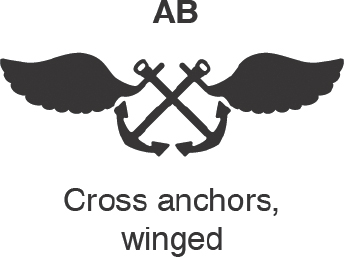
Aviation Boatswain’s Mate
ABs operate, maintain, and repair aircraft catapults, arresting gear, and barricades. They operate and maintain fuel- and lube-oil transfer systems. ABs direct aircraft on the flight deck and in hangar bays before launch and after recovery. They use tow tractors to position planes and operate support equipment used to start aircraft. (Service ratings: ABE [launching and recovery equipment]; ABF [fuels]; ABH [aircraft handling])
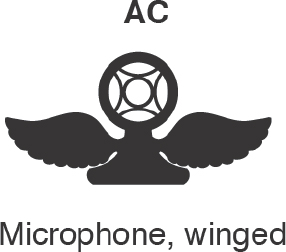
Air Traffic Controller
ACs assist in the essential safe, orderly, and speedy flow of air traffic by directing and controlling aircraft under visual (VFR) and instrument (IFR) flight rules. They operate field lighting systems, communicate with aircraft, and furnish pilots with information regarding traffic, navigation, and weather conditions. They operate and adjust GCA (ground-controlled approach) systems. They interpret targets on radar screens and plot aircraft positions.
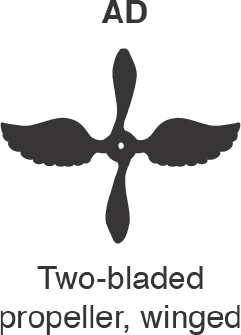
Aviation Machinist’s Mate
ADs maintain jet aircraft engines and associated equipment or engage in any one of several types of aircraft maintenance activities. ADs maintain, service, adjust, and replace aircraft engines and accessories, as well as perform the duties of flight engineers. (Compression rating: AF [Aviation Maintenanceman])

Aviation Electrician’s Mate
AEs maintain, adjust, and repair electrical-power generating, converting, and distributing systems, as well as lighting, control, and indicating systems in aircraft. They also install and maintain wiring and flight and engine instrument systems, which include automatic flight control, stabilization, aircraft compass, attitude reference, and inertial navigation systems. (Compression rating: AV [Avionics Technician])
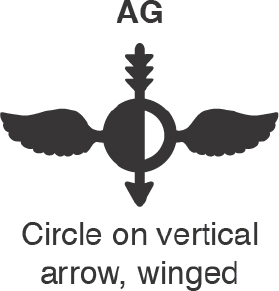
Aerographer’s Mate
The Navy has its own weather forecasters, AGs, who are trained in meteorology and the use of aerological instruments that monitor such weather characteristics as air pressure, temperature, humidity, wind speed, and wind direction. They prepare weather maps and forecasts, analyze atmospheric conditions to determine the best flight levels for aircraft, and measure wind and air density to increase the accuracy of antiaircraft firing, shore bombardment, and delivery of weapons by aircraft.

Aviation Structural Mechanic
The maintenance and repair of aircraft parts (wings, fuselage, tail, control surfaces, landing gear, and attending mechanisms) are performed by AMs working with metals, alloys, and plastics. AMs maintain and repair safety equipment and hydraulic systems. (Service rating: AME [safety equipment]) (Compression rating: AF [Aviation Maintenanceman])

Aviation Ordnanceman
Navy planes carry guns, bombs, torpedoes, rockets, and missiles to attack the enemy on the sea, under the sea, in the air, and on land. AOs are responsible for maintaining, repairing, installing, operating, and handling aviation ordnance equipment; their duties also include the handling, stowing, issuing, and loading of munitions and small arms.
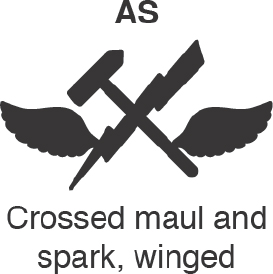
Aviation Support Equipment Technician
ASs perform intermediate maintenance on “yellow” (aviation accessory) equipment at naval air stations and aboard carriers. They maintain gasoline and diesel engines, hydraulic and pneumatic systems, liquid and gaseous oxygen and nitrogen systems, gas-turbine compressor units, and electrical systems.
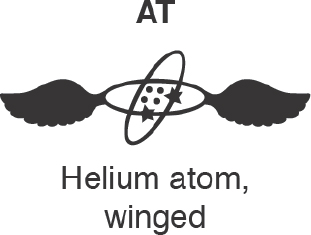
Aviation Electronics Technician
ATs perform preventive and corrective maintenance on aviation electronic components supported by conventional and automatic test equipment. They repair the electronic components of equipment associated with weapons, communications, radar, navigation, antisubmarine warfare sensors, electronic warfare, data links, fire control, and tactical displays. (Compression rating: AV [Avionics Technician])
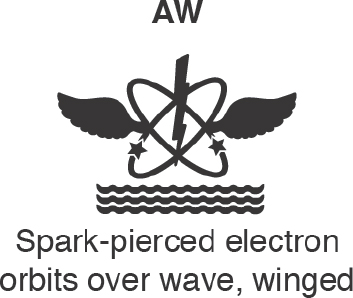
Naval Air Crewman
AWs perform a wide variety of functions in many of the Navy’s aircraft, such as operating electronic equipment (radars, radios, etc.), performing search-and-rescue techniques, etc. (Service ratings: AWF [mechanical]; AWO [operator]; AWR [tactical helicopter]; AWS [helicopter]; AWV [avionics])

Aviation Maintenance Administrationman
AZs perform clerical, administrative, and managerial duties necessary to keep aircraft maintenance activities running smoothly. They plan, schedule, and coordinate maintenance, including inspections and modifications to aircraft and equipment.

Boatswain’s Mate
BMs train, direct, and supervise others in marlinespike, deck, and boat seamanship; ensure proper upkeep of the ship’s external structure, rigging, deck equipment, and boats; lead working parties; perform seamanship tasks; are in charge of picketboats, self-propelled barges, tugs, and other yard and district craft; serve in or are in charge of gun crews and damage-control parties; and use and maintain equipment for loading and unloading cargo, ammunition, fuel, and general stores.

Builder
Navy BUs are similar to civilian construction workers. They may be skilled carpenters, plasterers, roofers, cement finishers, asphalt workers, masons, painters, bricklayers, sawmill operators, or cabinet-makers. BUs build and repair all types of structures, including piers, bridges, towers, underwater installations, schools, offices, houses, and other buildings. (Compression rating: CU [Constructionman])
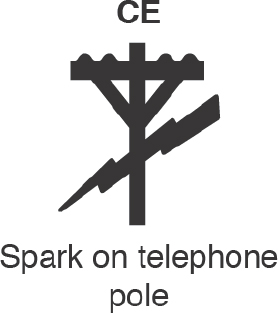
Construction Electrician
CEs are responsible for the power production and electrical work required to build and operate airfields, roads, barracks, hospitals, shops, and warehouses. The work of Navy CEs is like that of civilian construction electricians, powerhouse electricians, telephone and electrical repairmen, substation operators, linemen, and others. (Compression rating: UC [Utilities Constructionman])
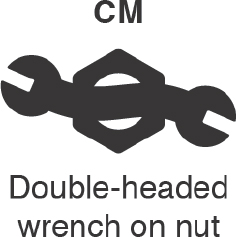
Construction Mechanic
CMs maintain heavy construction and automotive equipment (buses, dump trucks, bulldozers, rollers, cranes, backhoes, and pile drivers) as well as other construction equipment. They service vehicles and work on gasoline and diesel engines, ignition and fuel systems, transmissions, electrical systems, and hydraulic, pneumatic, and steering systems. (Compression rating: EQ [Equipmentman])

Culinary Specialist
CSs operate and manage Navy dining facilities and bachelor enlisted quarters. They are cooks and bakers in Navy dining facilities ashore and afloat, ordering, inspecting, and stowing food. They maintain food service and preparation spaces and equipment and keep records of transactions and budgets for the food service in living quarters ashore.

Cryptologic Technician
Depending on their special career area, CTs control access to classified material, translate foreign-language transmissions, operate radio direction-finding equipment, employ electronic countermeasures, and install, service, and repair special electronic and electromechanical equipment. CTs require special security clearances. (Service ratings: CTI [interpretive]; CTM [maintenance]; CTN [network]; CTR [collection]; CTT [technical])
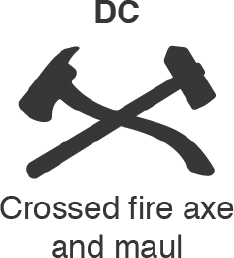
Damage Controlman
DCs perform the work necessary for damage control, ship stability, firefighting, and chemical, biological, and radiological (CBR) warfare defense. They instruct personnel in damage control and CBR defense and repair damage-control equipment and systems.
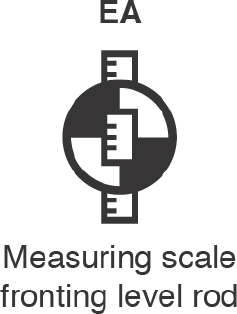
Engineering Aide
EAs provide construction engineers with the information needed to develop final construction plans. EAs conduct surveys for roads, airfields, buildings, waterfront structures, pipelines, ditches, and drainage systems. They perform soil tests, prepare topographic and hydrographic maps, and survey for sewers, water lines, drainage systems, and underwater excavations. (Compression rating: CU [Constructionman])

Electrician’s Mate
The operation and repair of a ship’s or station’s electrical powerplant and electrical equipment are the responsibilities of EMs. They also maintain and repair power and lighting circuits, distribution switchboards, generators, motors, and other electrical equipment.

Engineman
Internal-combustion engines, either diesel or gasoline, must be kept in good order; this is the responsibility of ENs. They are also responsible for the maintenance of refrigeration, air-conditioning, and distilling-plant motors and compressors.
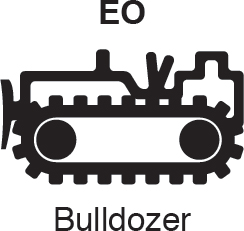
Equipment Operator
EOs work with heavy machinery such as bulldozers, power shovels, pile drivers, rollers, and graders. EOs use this machinery to dig ditches and excavate for building foundations, to break up old concrete or asphalt paving and pour new paving, to loosen soil and grade it, to dig out tree trunks and rocks, to remove debris from construction sites, to raise girders, and to move and set in place other pieces of equipment or materials needed for a job. (Compression rating: EQ [Equipmentman])
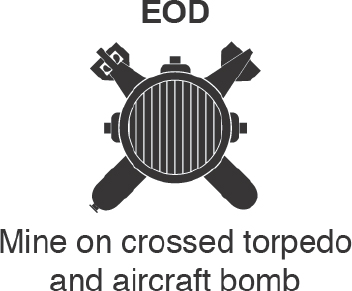
Explosive Ordnance Disposal Technician
EODs render safe all types of ordnance, both conventional and unconventional, improvised, chemical, biological, and nuclear. They perform a wide variety of ordnance-related tasks, including underwater location, identification, render-safe, demolition, recovery, and disposal of foreign and domestic ordnance. They also support military and civilian law enforcement agencies.

Electronics Technician
ETs are responsible for electronic equipment used to send and receive messages, detect enemy planes and ships, and determine target distance. They must maintain, repair, calibrate, tune, and adjust electronic equipment used for communications, detection and tracking, recognition and identification, navigation, and electronic countermeasures.
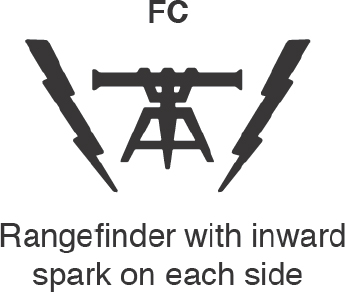
Fire Controlman
FCs maintain the control mechanism used in weapons systems on combat ships. Complex electronic, electrical, and hydraulic equipment is required to ensure the accuracy of guided-missile and surface gunfire-control systems. FCs are responsible for the operation, routine care, and repair of this equipment, which includes radars, computers, weapons-direction equipment, target-designation systems, gyroscopes, and rangefinders.
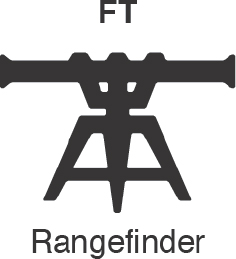
Fire Control Technician
FTs maintain advanced electronic equipment used in submarine weapons systems. Complex electronic, electrical, and mechanical equipment is required to ensure the accuracy of guided-missile systems and underwater weapons. FTs are responsible for the operation, routine care, and repair of this equipment.
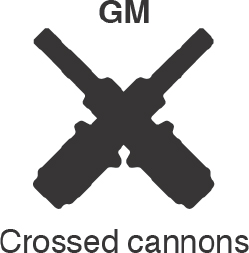
Gunner’s Mate
Navy GMs operate, maintain, and repair all gunnery equipment, guided-missile launching systems, rocket launchers, guns, gun mounts, turrets, projectors, and associated equipment. They also make detailed casualty analyses and repairs of electrical, electronic, hydraulic, and mechanical systems. They test and inspect ammunition and missiles and their ordnance components and train and supervise personnel in the handling and stowage of ammunition, missiles, and assigned ordnance equipment.

Gas Turbine Systems Technician
GSs operate, repair, and maintain gas-turbine engines, main propulsion machinery (including gears, shafting, and controllable-pitch propellers), assigned auxiliary equipment, propulsion-control systems, electrical and electronic circuitry up to printed circuit modules, and alarm and warning circuitry. They perform administrative tasks related to gas-turbine propulsion-system operation and maintenance. (Service ratings: GSE [electrical]; GSM [mechanical])
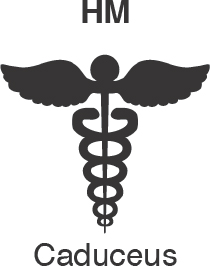
Hospital Corpsman
HMs assist medical professionals in providing health care to service people and their families. They act as pharmacists, medical technicians, food-service personnel, nurses’ aides, physicians’ or dentists’ assistants, battlefield medics, X-ray technicians, and more. Their work falls into several categories: first aid and minor surgery, patient transportation, patient care, prescriptions and laboratory work, food-service inspections, and clerical duties.
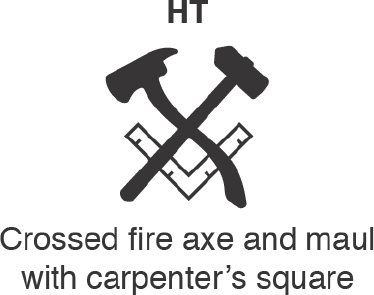
Hull Maintenance Technician
HTs are responsible for maintaining ships’ hulls, fittings, piping systems, and machinery. They install and maintain shipboard and shore-based plumbing and piping systems. They also look after a vessel’s safety and survival equipment and perform many tasks related to damage control.
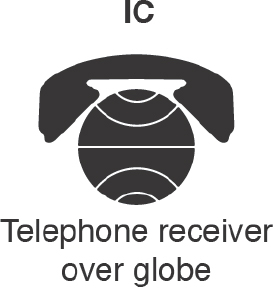
Interior Communications Electrician
ICs operate and repair electronic devices used in a ship’s interior communications systems—SITE TV systems, public-address systems, electronic megaphones, and other announcing equipment—as well as gyrocompass systems.

Intelligence Specialist
Military information, particularly classified information about enemies or potential enemies, is called “intelligence.” Intelligence specialists analyze intelligence data. They break down information to determine its usefulness in military planning. From these intelligence data, they prepare materials that describe in detail the features of strategic and tactical areas all over the world.

Information Systems Technician
ITs are responsible for the Navy’s vital command, control, communications, computer and intelligence systems, and equipment. They use state-of-the-art multimedia technology such as fiber optics, digital microwave, and satellites on a global basis and work with telecommunications equipment, computers, and associated peripheral devices. (Service rating: ITS [submarines])
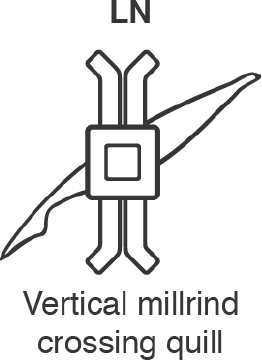
Legalman
Navy LNs are aides trained in the field of law. They work in Navy legal offices performing administrative and clerical tasks necessary to process claims, to conduct court and administrative hearings, and to maintain records, documents, and legal-reference libraries. They give advice on tax returns, voter-registration regulations, procedures, and immigration and customs regulations governing Social Security and veterans’ benefits and perform many duties related to courts-martial and nonjudicial hearings.

Logistics Specialists
LSs are the Navy’s supply clerks. They see that needed supplies are available, including everything from clothing and machine parts to forms and food. They serve as civilian warehousemen, purchasing agents, stock clerks and supervisors, retail sales clerks, store managers, inventory clerks, buyers, parts clerks, bookkeepers, and even forklift operators. They also provide postal system services for the Navy to ensure an efficient interface between the U.S. Postal Service and the fleet.

Master-at-Arms
MAs help keep law and order aboard ship and at shore stations. They report to the executive officer, help maintain discipline, and assist in security matters. They enforce regulations, conduct investigations, take part in correctional and rehabilitative programs, and organize and train Sailors assigned to police duty. In civilian life, they would be detectives and policemen.
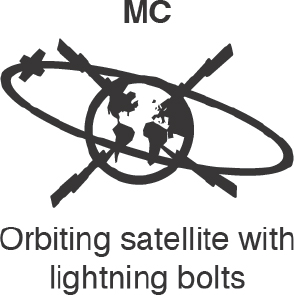
Mass Communications Specialist
MCs are public affairs and visual information experts. They present the Navy story to audiences in the Navy and to the rest of the world through a variety of media. MCs write and produce print and broadcast journalism news and feature stories for military and civilian newspapers, magazines, television, and radio. They use photography, web design, graphic design, and other related skills in the performance of their duties.

Machinist’s Mate
Continuous operation of the many engines, compressors and gears, refrigeration, air-conditioning, gas-operated equipment, and other types of machinery afloat and ashore is the job of the MM. In particular, MMs are responsible for a ship’s steam propulsion and auxiliary equipment and the outside (deck) machinery. MMs may also perform duties in the manufacture, storage, and transfer of some industrial gases. (Service ratings: MME (auxiliary); MMN [nuclear]; MMW [weapons])

Mineman
MNs test, maintain, repair, and overhaul mines and their components. They are responsible for assembling, handling, issuing, and delivering mines to the planting agent and for maintaining mine-handling and mine-laying equipment.

Machinery Repairman
MRs are skilled machine-tool operators. They make replacement parts and repair or overhaul a ship engine’s auxiliary equipment, such as evaporators, air compressors, and pumps. They repair deck equipment, including winches and hoists, condensers, and heat-exchange devices. Shipboard MRs frequently operate main propulsion machinery in addition to performing machine-shop and repair duties.

Missile Technician
MTs perform organizational and intermediate-level maintenance on ballistic-missile weapons systems; they also operate and maintain their fire-control systems, guidance subsystems, and associated test equipment, as well as missile and launcher/tuber groups and all ancillary equipment. They operate and maintain strategic weapons systems, associated ship/weapon subsystems, and test and handling equipment.

Musician
MUs play in official Navy bands and in special groups such as jazz bands, dance bands, and small ensembles. They give concerts and provide music for military ceremonies, religious services, parades, receptions, and dances. Official unit bands usually do not include stringed instruments, but each MU must be able to play at least one brass, woodwind, or percussion instrument. Persons are selected for this rating through auditions.
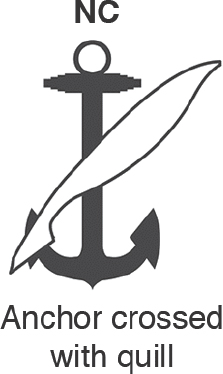
Navy Counselor
NCs offer vocational guidance on an individual and group basis to Navy personnel aboard ships and at shore facilities and to civilian personnel considering enlistment in the Navy. They assess the interests, aptitudes, abilities, and personalities of individuals. An NCR (Navy Counselor Recruiter) focuses on bringing people into the Navy and helps new recruits make early career decisions. NCCs (Navy Career Counselors) primarily work with personnel further along in their careers, assisting them with such things as advancing their education, converting their ratings, and improving their chances for retention and promotion.
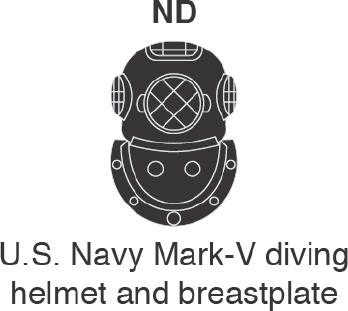
Navy Diver
NDs perform underwater construction, salvage, repair, maintenance, demolition, reconnaissance, and search-and-rescue tasks using a variety of diving equipment. They also support Special Warfare and Explosive Ordnance Disposal personnel (see SO and EOD ratings).

Operations Specialist
OSs operate radar, navigation, and communications equipment in a ship’s combat information center (CIC) or on the bridge. They detect and track ships, planes, and missiles. They operate and maintain IFF (identification friend or foe) systems, ECM (electronic countermeasures) equipment, and radiotelephones. OSs also work with search-and-rescue teams.
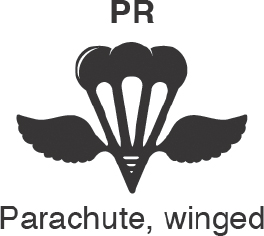
Aircrew Survival Equipmentman
Parachutes are the lifesaving equipment of aviators when they have to bail out. In times of disaster, a parachute may also be the only means of delivering badly needed medicines, goods, and other supplies to isolated victims. PRs pack and care for parachutes as well as service, maintain, and repair flight clothing, rubber life rafts, life jackets, oxygen-breathing equipment, protective clothing, and air-sea rescue equipment. An Aircrew Survival Equipmentman was originally called a “Parachute Rigger,” which explains the rating abbreviation “PR.”

Personnel Specialist
Those Sailors in the PS rating provide enlisted personnel with information and counseling related to Navy occupations, opportunities for general education and job training, requirements for promotion, and rights and benefits. PSs maintain and audit pay and personnel records and determine military pay and travel entitlements. They prepare financial and accounting reports related to individual pay and travel transactions and operate associated accounting systems.
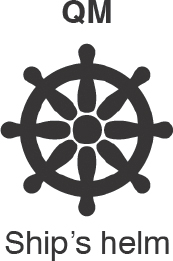
Quartermaster
QMs are responsible for ship safety, skillful navigation, and reliable communications with other vessels and shore stations. In addition, they maintain charts, navigational aids, and records for the ship’s log. They steer the ship, take radar bearings and ranges, make depth soundings and celestial observations, plot courses, command small craft, conduct honors and ceremonies with passing ships, maintain signaling equipment, and send and receive visual signals by flashing light, semaphore, and flaghoist. QMs stand watch and assist the navigator and officer of the deck (OOD).

Religious Program Specialist
RPs assist Navy chaplains with administrative and budgetary tasks. They serve as custodians of chapel funds, keep religious documents, and maintain contact with religious and community agencies. They also prepare devotional and religious educational materials, set up volunteer programs, operate shipboard libraries, supervise chaplains’ offices, and perform administrative, clerical, and secretarial duties. They train personnel in religious programs and publicize religious activities.
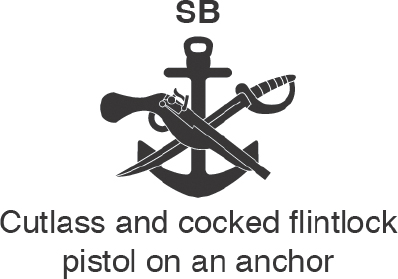
Special Warfare Boat Operator
SBs drive a variety of special warfare craft. They support SEALs and other Special Operations Command forces during their maritime and riverine missions and conduct unconventional small boat operations such as coastal/riverine patrols. They collect intelligence on enemy military installations in coastal areas, perform parachute/helicopter insertion operations, and support military and civilian law enforcement operations.

Ship’s Serviceman
Both ashore and afloat, SHs manage barbershops, tailor shops, ships’ uniform stores, laundries, dry-cleaning plants, and cobbler shops. They serve as clerks in exchanges, convenience stores, gas stations, warehouses, and commissary stores. Some SHs function as Navy club managers.

Special Warfare Operator
SOs are better known as SEALs—an acronym from one of their primary missions: conducting insertions/extractions from the sea, air, or land. SOs also conduct covert, special operations missions in virtually any environment throughout the world, capture high-value enemy personnel and terrorists, collect information and intelligence through special reconnaissance missions, carry out small-unit, direct-action missions against military targets, and conduct underwater reconnaissance and demolition of natural or man-made obstacles prior to amphibious landings.

Sonar Technician
STs operate sonar and other oceanographic systems. They manipulate, control, evaluate, and interpret data for surface and submarine operations. STs coordinate submarine and auxiliary sonar and underwater fire-control interface, operate surface-ship underwater fire-control systems and associated equipment for the solution of antisubmarine warfare problems, and perform organizational and intermediate maintenance on their respective sonar and allied equipment. (Service ratings: STG [surface]; STS [submarine])

Steelworker
SWs rig and operate all special equipment used to move or hoist structural steel, structural shapes, and similar material. They erect or dismantle steel bridges, piers, buildings, tanks, towers, and other structures. They place, fit, weld, cut, bolt, and rivet steel shapes, plates, and built-up sections used in the construction of overseas facilities. (Compression rating: CU [Constructionman])
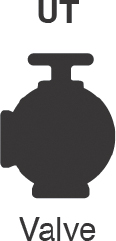
Utilitiesman
UTs plan, supervise, and perform tasks involved in the installation, operation, maintenance, and repair of plumbing, heating, steam, compressed-air systems, fuel-storage and -distribution systems, water-treatment and -distribution systems, air-conditioning and refrigeration equipment, and sewage-collecting and disposal facilities. (Compression rating: UC [Utilities Constructionman])

Yeoman
YNs perform secretarial and clerical work. They greet visitors, answer telephone calls, and receive incoming mail. YNs organize files and operate duplicating equipment, and they order and distribute supplies. They write and type business and social letters, notices, directives, forms, and reports. They maintain files and service records.
Even though some Sailors in pay grades E-1 through E-3 may not yet have a rating, they still work within the general parameters of the occupational field (apprenticeship) that they seek. Sailors who are aspiring to (“striking for” in Navy parlance) a particular rating will have the appropriate “general rate” for that general field. As you can see below, a Sailor seeking a rating within the category of engineering would have the general rate of “Fireman” while a Sailor seeking a rating in aviation would be an “Airman.”
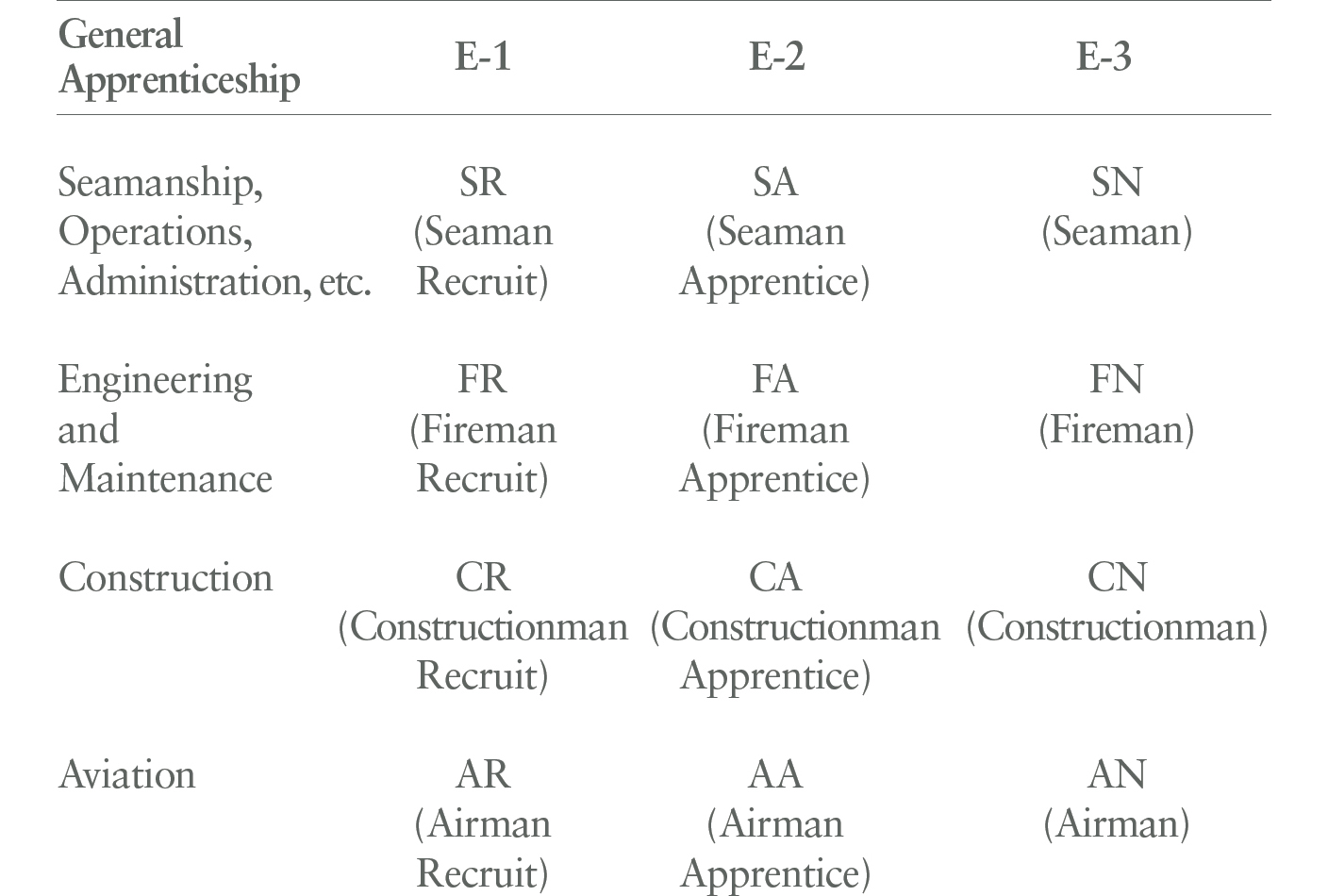
5-D Examples of Enlisted Career Advancement
The example below shows the advancement of a typical general rating (Boatswain’s Mate).

This example shows the advancement of a typical service rating (Aircrew Survival Equipmentman). Note that this individual became a “designated striker” for her rating at the E-3 level.

In this example, this Sailor began his career in the construction general apprenticeship, was then rated as a Construction Electrician and merged with the Utilitiesman rating at the E-9 level. This is an example of a compression rating.
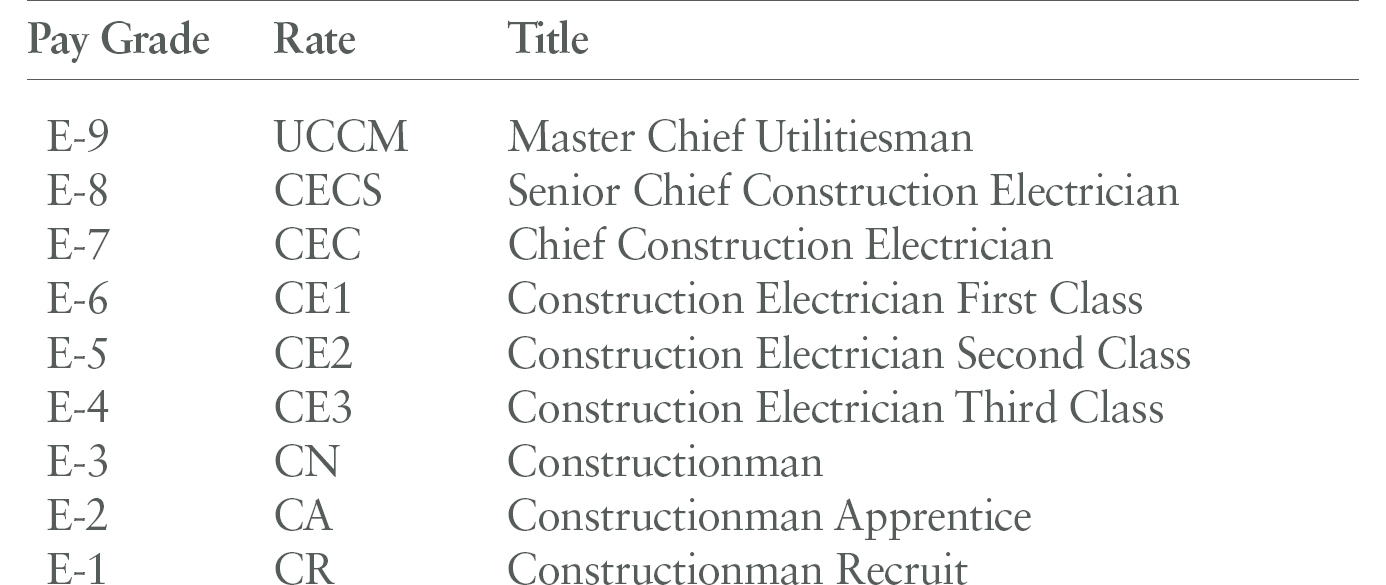
In this example, this Sailor began her career in the aviation general apprenticeship and then was rated as an Aviation Boatswain’s Mate, with a service rating in fuels. That service rating is indicated by the addition of a third rating letter—“F” in this case. Had her service rating been in aircraft handling, the F would be replaced by H, so that her rating would be ABH instead of ABF.
